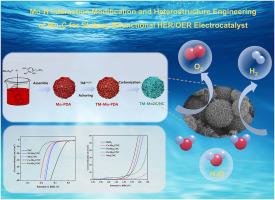Mo-H interaction modification and heterostructure engineering of Mo2C for striking water splitting electrocatalyst
IF 7.9
2区 工程技术
Q1 CHEMISTRY, PHYSICAL
引用次数: 0
Abstract
Facing the inherent sluggish hydrogen evolution reaction/oxygen evolution reaction (HER/OER) kinetics of Mo2C catalyst, a straightforward and scalable approach is proposed to synthesize flower-like heterojunction catalysts TM-Mo2C/NC, consisting of carbon nanosheets doped with nitrogen and Mo2C nanoparticles doped with transition metals (Fe, Co, Ni). Benefiting from the layered hollow sphere framework that provides numerous active sites, the Ni-Mo2C/NC catalyst demonstrates outstanding HER activity, achieving an overpotential of 111 mV at 10 mA cm−2. Co-Mo2C/NC has the lowest Tafel slope of 54.9 mV dec−1 during the OER process, indicating the highest inherent catalytic activity. The synergistic effect of Mo-H interaction regulation and heterostructure construction can be achieved by the TM dopant, which significantly improves the HER/OER activity. This work offers an effective strategy for devising high efficiency Mo2C-based catalysts for energy conversion.

冲击水裂解电催化剂Mo2C的Mo-H相互作用改性及异质结构工程
针对Mo2C催化剂固有的析氢/析氧反应(HER/OER)动力学缓慢的问题,提出了一种简单、可扩展的方法来合成由掺杂氮的碳纳米片和掺杂过渡金属(Fe, Co, Ni)的Mo2C纳米颗粒组成的花状异质结催化剂TM-Mo2C/NC。Ni-Mo2C/NC催化剂得益于层状中空球体框架,提供了许多活性位点,表现出出色的HER活性,在10 mA cm - 2下实现了111 mV的过电位。在OER过程中,Co-Mo2C/NC的Tafel斜率最低,为54.9 mV dec−1,表明其内在催化活性最高。TM掺杂剂可以实现Mo-H相互作用调控和异质结构构建的协同效应,显著提高HER/OER活性。这项工作为设计高效mo2c基能量转换催化剂提供了有效的策略。
本文章由计算机程序翻译,如有差异,请以英文原文为准。
求助全文
约1分钟内获得全文
求助全文
来源期刊

Journal of Power Sources
工程技术-电化学
CiteScore
16.40
自引率
6.50%
发文量
1249
审稿时长
36 days
期刊介绍:
The Journal of Power Sources is a publication catering to researchers and technologists interested in various aspects of the science, technology, and applications of electrochemical power sources. It covers original research and reviews on primary and secondary batteries, fuel cells, supercapacitors, and photo-electrochemical cells.
Topics considered include the research, development and applications of nanomaterials and novel componentry for these devices. Examples of applications of these electrochemical power sources include:
• Portable electronics
• Electric and Hybrid Electric Vehicles
• Uninterruptible Power Supply (UPS) systems
• Storage of renewable energy
• Satellites and deep space probes
• Boats and ships, drones and aircrafts
• Wearable energy storage systems
 求助内容:
求助内容: 应助结果提醒方式:
应助结果提醒方式:


